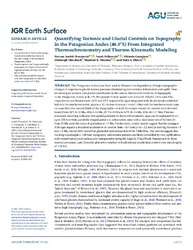Quantifying Tectonic and Glacial Controls on Topography in the Patagonian Andes (46.5°S) From Integrated Thermochronometry and Thermo‐Kinematic Modeling
Andrić‐Tomašević, Nevena
Georgieva, Viktoria
DOI: https://doi.org/10.1029/2020JF005993
Persistent URL: http://resolver.sub.uni-goettingen.de/purl?gldocs-11858/9532
Persistent URL: http://resolver.sub.uni-goettingen.de/purl?gldocs-11858/9532
Andrić‐Tomašević, Nevena; Falkowski, Sarah; Georgieva, Viktoria; Glotzbach, Christoph; Strecker, Manfred R.; Ehlers, Todd A., 2021: Quantifying Tectonic and Glacial Controls on Topography in the Patagonian Andes (46.5°S) From Integrated Thermochronometry and Thermo‐Kinematic Modeling. In: Journal of Geophysical Research: Earth Surface, Band 126, 8, DOI: 10.1029/2020JF005993.
 |
Dokument öffnen: |
The Patagonian Andes have been used to illustrate the dependency of major topographic changes in response to glacial erosion processes dominating over tectonic deformation and uplift. Here, we investigate tectonic and glacial contributors to the erosion history and evolution of topography in the Patagonian Andes at 46.5°S. We present 33 new apatite and zircon (U‐Th)/He (AHe and ZHe, respectively) and fission track (AFT and ZFT, respectively) ages integrated with 46 previously published bedrock thermochronometric ages in a 3D thermo‐kinematic model. Observed thermochronometer ages increase from the eastern flank of the topographic crest of the orogen toward the eastern retro‐foreland basin (from AFT 4–10 Ma, ZHe 4–12 Ma, ZFT 6–14 Ma to AFT 28–32 Ma, ZHe 68–117 Ma). Thermo‐kinematic modeling indicates that spatial gradients in thermochronometric ages can be explained by an up to 100‐km‐wide, parabolic‐shaped pattern in exhumation rates with a maximum rate of 0.5 mm/yr from 15 Ma until the onset of glaciation at ∼7 Ma. Furthermore, model results suggest that the youngest AHe ages require a localized acceleration in erosion from ∼0.5 mm/yr to ∼2.2 mm/yr starting between ∼5 and ∼3 Ma, coeval with intensified glaciation and subduction of the Chile Rise. Our results suggest that the long‐wavelength (∼100 km) topography and erosion patterns are likely controlled by rock uplift above mid‐crustal ramp(s) and subsequent transpression along the Liquiñe‐Ofqui Fault. Superposed on these tectonic processes, Late Cenozoic glaciation resulted in localized and accelerated erosion over wavelengths of <20 km. Key Points:
Low‐temperature thermochronology records non‐uniform erosion in the retro‐wedge of the Southern Patagonian Andes.
Erosion pattern and long‐wavelength topography are largely a function of regional tectonic activity over the last 15 Myr.
Glaciation has modified erosion rates and topography on sub‐valley scales over the last 5–3 Myr.
Statistik:
ZugriffsstatistikSammlung:
- Geologie [933]
Schlagworte:
erosion ratetopography
glacial erosion
thermochronology
thermo‐kinematic numerical modeling
Patagonian Andes
This is an open access article under the terms of the Creative Commons Attribution‐NonCommercial License, which permits use, distribution and reproduction in any medium, provided the original work is properly cited and is not used for commercial purposes.

